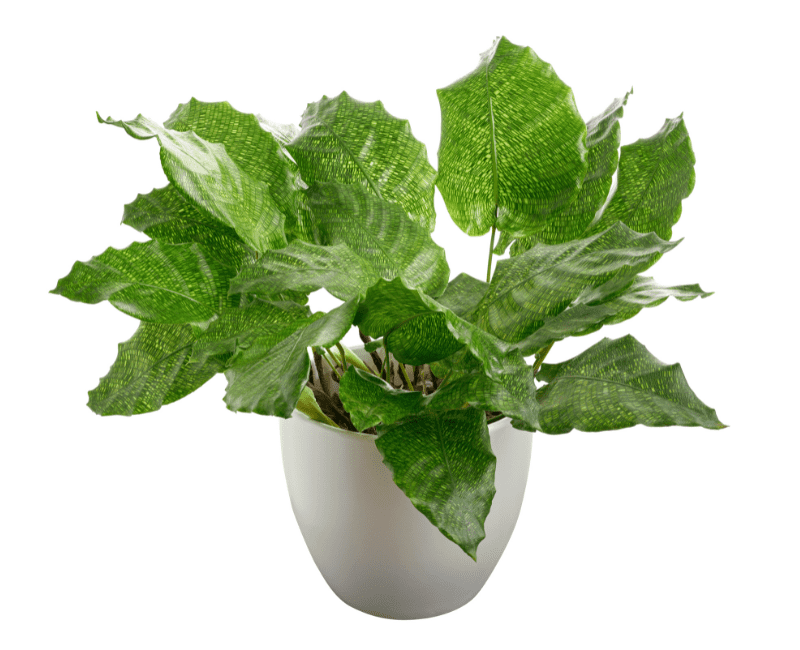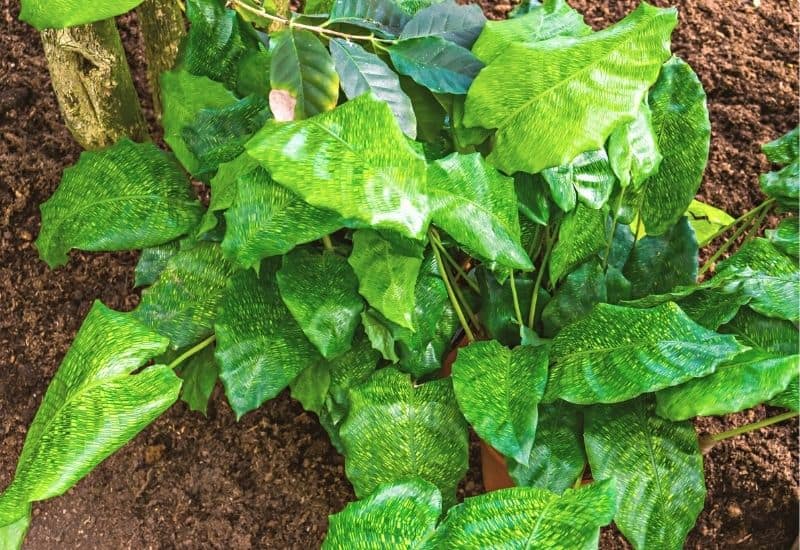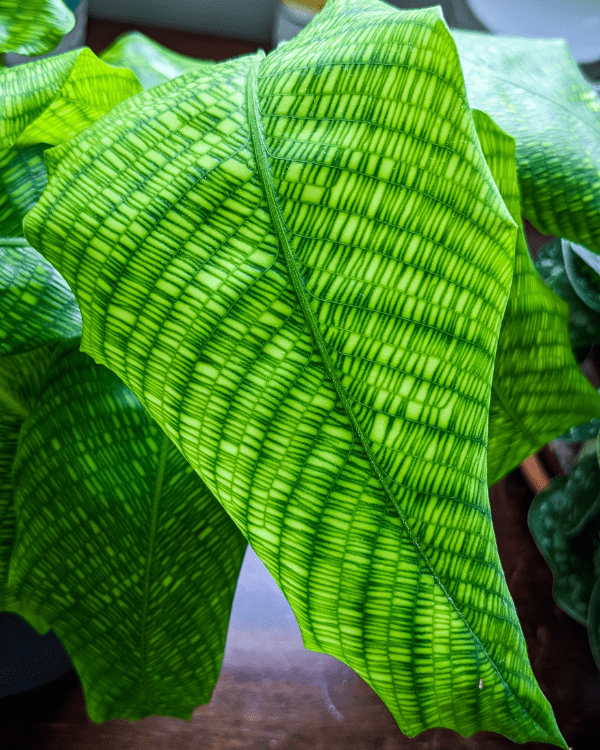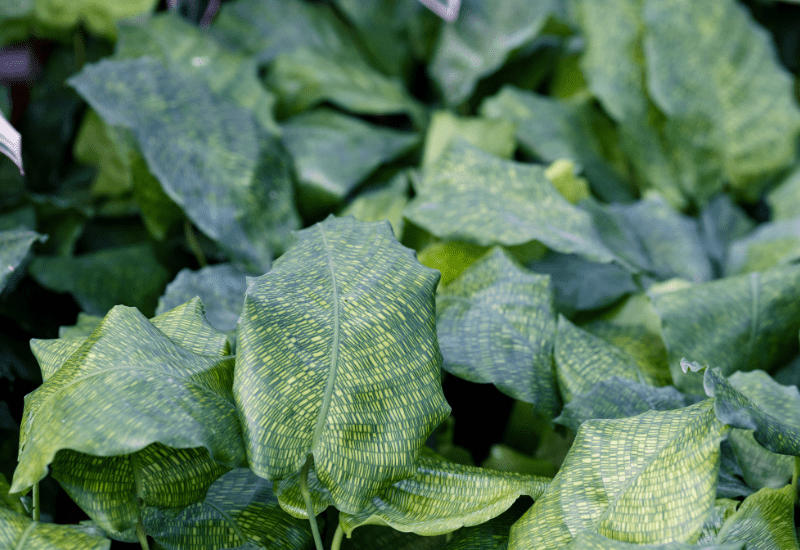The Calathea Musaica Plant has been around for centuries. The plant is native to tropical regions and thrives in humid, warm climates. The plant’s leaves are large and broad with a matte finish that ranges from dark green to light brown in coloration.
They can grow up to 5 feet tall at their maximum height! This article will provide you with information about how often the Calathea Musaica needs watering, what type of soil it prefers, and other essential facts about this beautiful houseplant!
Calathea Musaica Care Guide Overview
- How To Plant (when & where)
- How To Grow (staking, watering, fertilizing, humidity, mulching)
- How To Trim And Prune
- How To Pot And Repot
- How To Propagate (when & how)
- And Pests and Diseases, Plant Species, Companions, Toxicity
Characteristics
- Scientific Name: Calathea musaica
- Common Name: Calathea
- Origin: Tropical regions in South America, Southeast Asia
- Type: Houseplant (indoor). Best suited for indoor growing. The Calathea Musaica Plant is not recommended to be grown outdoors in colder climates because it does not like cold temperatures and will die when exposed to them for too long. If you live in an area with frequent freeze warnings during the winter months (temperatures below 32° F), consider placing your plant outside only during warmer summer days so that it can experience what little sun comes through at this time of year! It’s also important to note that moving plants from one environment to another suddenly may cause stress or shock, leading to poor health or death depending on how sudden the change was made. This means no taking your Calathea Musaica outside for summer vacations.
- Height and structure: Grows to be up to five feet tall | Broad leaves with a matte finish that ranges from dark green to light brown in coloration
- Temperature.: Prefers cool to warm temperatures
- Flower Color: There are no flowers except for exceptions like C. crocata species, which produce orange-colored flowers.
How to Plant the Calathea Musaica

Planting Time
Prefers cool temperatures. It is preferable if you grow the rhizome plant when the temperatures are cool. A sizeable pot of around 8 inches is preferred because the plant starts to be rootbound in 2-3 years. It is not advisable to rush to transfer the plant.
Where to plant
Prefers filtered sunlight and adapt to lower light conditions. Calathea Musaica does not thrive in the wild. It is a perfect indoor plant that should be planted in Noth or East facing windowsill. If you grow it in the North facing windowsill, ensure a partial shade to avoid the midday sun, which might burn its leaves, leading to discoloration.
Spacing
Place the plant about 30-36 inches apart.
Light Exposure
Partial sun to light shade. Needs warm temperatures 20°C – 24°C (68°F – 75°F). It prefers moist soil but never wet. Calathea Musaica tolerates dry air well once established. Water sparingly during summer months, or plants will drop leaves!
Soil
Potting mix that is moist but well-drained. Use a pot with ample drainage holes to prevent root rot. Additionally, the ground should contain peat or organic material with an acidic pH of up to neutral level.
How to Grow the Calathea Musaica

Growth Habits
In the first year of growth, Calathea Musaica produces a rosette with wavy-edged leaves. In subsequent years, it will form an upright stem that grows new foliage at its apex.
The plant is suitable for air purification by removing xylene and toluene from indoor air and other VOCs (volatile organic compounds). It also removes ammonia, benzene, and formaldehyde from indoor air.
Growth rate: Moderate growth if well taken care of.
Leaf and Stem Damage

Where does Calathea Musaica’s damage come from? | It may be caused by over or under-watering, exposure to cold temperatures, direct sunlight that burns leaves, leading to discoloration of leaves, and pests such as Scale Insects or Mealy Bugs. Insects infestations cause yellow spots on lower leaf surfaces and stunted growth if infestations are severe enough.
Watering
Calathea Musaica Plant is known for its water needs. The plant will thrive if you keep it moist but not soggy with much-standing water and dry between watering times. It prefers soil that drains well rather than saturated, wet soils because this can cause root rot diseases. The best time for watering is during the morning hours to allow proper ventilation before nightfall or when there are no leaves on the plant. Overwatering may cause root rotting! This means too much moisture in your pot which results in damage to roots due To a lack of oxygen supply resulting from the excess amount of standing wáter.
Fertilizing

eed your Calathea Musaica once every month, from March to September, with a balanced fertilizer diluted by half. For example, if you are using 20-20-20 NPK Fertilizer, then mix it in the ratio of one part fertilizer to two parts water and apply this mixture around the plant’s drip line or where there is no stem formation. Avoid touching the leaves when using fertilizers because they can cause spotting or browning, which will result in defoliation!
Tips for fertilizing Calathea Musaica:
- Never apply liquid fertilizers on dry soil to avoid burning the roots
- Fertilizers should only be applied during the growing season. Once in early spring, and at the start and end of summer.
- The soil should be flushed from time to time with lukewarm distilled water to avoid mineral buildup.
Humidity
Prefer humidity levels between 40-70% indoors but will tolerate fluctuation throughout its lifetime. Lower humidity leads to more frequent watering, while higher humidity slows down growth and reduces leaf size/production rates.
Mulching
To retain moisture and prevent weeds, mulch with a few inches of organic material.
Trimming and pruning
Regular pruning and trimming are necessary if you want to keep your Calathea Musaica in good shape.
Pruning: Prune away dead leaves at any time of year without removing too many healthy ones along with them – just enough to create an attractive shape that fits the dimensions of your space! Remove damaged tissue on lower/older foliage before it can become a site for infection by the fungus.
Trim off any dead leaves at the base of plants and pinch tips periodically to promote branching.
Size of The Calathea Musaica Plant: Stems are about 0.75 to almost one inch in diameter, with leaves varying in size between 12 and 24 inches long depending on the cultivar.
Pot and re-potting
Pot size & Growth rate of Calathea Musaica Plant: Large, fast-growing. Height can grow up to 30 inches or more if given time and proper care. It grows almost as wide, but placement in the center of its container is suggested to get enough water which may be an issue depending on your watering routine. Roots are susceptible – do not overpot this plant! Keep soil moist at all times; never allow the ground to become dry until top inch before first watering again after drying out between regularly scheduled waterings once every one week or two weeks with tap water. Preferably rainwater for best results.
Re-pot every two years or when the plant has outgrown its present container. Calatheas resent being disturbed and will react by dropping their leaves; hence they should only be moved during the repotting season, which is early spring or late summer! When doing so, use an all-purpose soil mixture with added clean sand ( one part sand: two parts peat ) to ensure good drainage for both overwintering and regular care after that. The newly potted plant may require protection from direct sunlight until acclimated; therefore, keep them under shade for a few days.
Calathea Musaica Propagation
Propagating Calathea Musaica: Propagation is carried out by division of crowns or from rhizome cuttings in spring or summer. Make sure you use sterilized, sharp shears when dividing the roots and ensure that all parts are healthy with no sign of rot. To propagate from an offset, it must be removed using a clean cutting instrument such as pruning shears at its base, where there will usually be one node with several shoots ready for propagation. Immediately after removing each shoot, immerse them in lukewarm water until they can be planted in moist peat-based potting compost to root. Once the roots have formed, they can be repotted into a larger pot if necessary and continue growing to build up strength.
Divide and transplant
To propagate Calathea Musaica, divide the crowns in spring or summer. Make sure you use sterilized tools to avoid introducing any harmful pathogens into your plant!
The divisions must have several shoots with a healthy root system each. Immediately after removing each node from the parent, immerse them in lukewarm water until they can be planted with moist peat-based potting compost to root. Once roots have formed, they can be repotted into a larger pot if necessary and continue growing while building up strength for transplanting outdoors later on!
Monocarpic: Some plants are monocarpic, which means that they only flower once before dying, but what’s interesting is that their offspring will carry the characteristics of their parents (in this case, the Calathea musaica plant). The offspring will flower only once before dying. After which, it will produce offsets or offshoots.
How to Propagate Offsets of Musaica?
Offsets are tiny plants that grow beside the main plant – usually attached by underground stems called stolons. To propagate your Musaica using new offset’s is easy! When grown in containers, these plants often send out runners along the soil’s surface and then produce roots at leaf nodes while allowing shoots to continue growing upwards towards the light! Detach a young runner with several leaves from its parent stem (gently pull) and transplant immediately into a fresh potting mix. New roots should appear within days under the right conditions!
Pests and diseases
The Calathea Musaica is susceptible to scale insects or mealybugs, which are sap-sucking pests that cause yellow spots on lower leaf surfaces and stunted growth if infestations are severe enough. In most cases, these symptoms do not lead to permanent problems unless they continue unchecked for months at a time. Regularly inspect the undersides of leaves for signs of their presence – in case you spot them, use an insecticidal soap spray diluted according to the manufacturer’s instructions will help get rid of this problem!
The Calathea Musaica is sometimes affected by fungal infections such as stem and root rots. To avoid this, ensure you provide adequate drainage for each pot to promote healthy growth with solid roots! Constantly water sparingly in the heat of summer when plants are dormant. If a fungus has attacked your plant, it may be possible to save the leaves, but only if spotted early enough before any permanent damage occurs! Remove all diseased tissue from lower leaf surfaces using clean cutting instruments such as pruning shears and treat stems and crowns with fungicide.
Plant Species
- Family: Marantaceae
- Species: G. kegeljanii
- Genus: Goeppertia
- Noteworthy species among Calethea Musaica: G. kegeljanii (synonym: Calathea kegeliana)
Native to Brazil, this rare species is closely related to the common Musaica plant and has dark green leaves with prominent silver veins. This small-sized evergreen perennial likes warm temperatures around 20°C – 24°C (68°F – 75°F).
Although it’s not an actual aquatic plant, you can use water sparingly when watering during the summer months to keep the compost moist but never wet. It tolerates low humidity levels well! Remember that your plants should be kept dry at all times over-wintering, or they will drop their leaves!
The Calathea Musaica is a popular ornamental plant with stunning leaves and flowers, making it an ideal choice for growing indoors. This species of flowering plant within the Maranta family (from South America) has bold arrow-shaped leaves with attractive green and white variegations.
Its large size makes them best suited to roomy floor containers, while its brilliant colors add drama even when not in bloom! Most cultivars will only flower once every few years; however, they can be propagated efficiently from offsets or by dividing existing crowns!
Companions
The Calathea Musaica and the Anthurium andraeanum (commonly known as Flamingo flower) make a pretty combination when planted together. In matching containers!
Toxicity
All parts of the plant are poisonous if ingested, including cooked leaves. Symptoms may include vomiting, diarrhea, breathing difficulties, paralysis. Plants also cause skin irritation when touched! Always wear gloves when handling this tropical beauty.
The sap can be highly irritating to eyes or sensitive skin conditions such as dermatitis! If you suspect poisoning after ingesting any part of this plant, please immediately contact your local poison control center for emergency treatment advice.
How To Care For The Calathea Musaica Plant
Calatheas require a well-drained soil mix with lots of organic matter to thrive indoors during the winter months. Although they prefer bright indirect light, avoid direct sunlight, which may burn the leaves and make your plant wilt! Keep in mind that Calatheas store water in their leaves, so never allow them to stand in water. Always place your container on a saucer filled with pebbles and add fresh water until it begins to drain from the bottom of the pot.
Bloom Time of Year: Summer spring to autumn
Conclusion
Watering, exposure to cold temperatures, direct sunlight that burns leaves leads to discoloration of leaves. Pests such as Scale Insects or Mealy Bugs cause yellow spots on lower leaf surfaces, and small growth infestations are severe enough. In most cases, these symptoms do not lead to permanent problems unless they continue unchecked for months at a time – especially during winter months when light levels are low.
Do not water or mist your plants when they are in full sunlight because this can cause them to wilt due to their propensity for storing moisture within their foliage. Avoid repotting if possible since most species of Calatheas prefer smaller roots systems, but do so only every few years instead of yearly to minimize the risk of crown rot caused by root damage! You may also wish to install small rocks or pebbles beneath the pot before adding fresh soil; this will help keep drainage holes open and provide better aeration for the roots.


